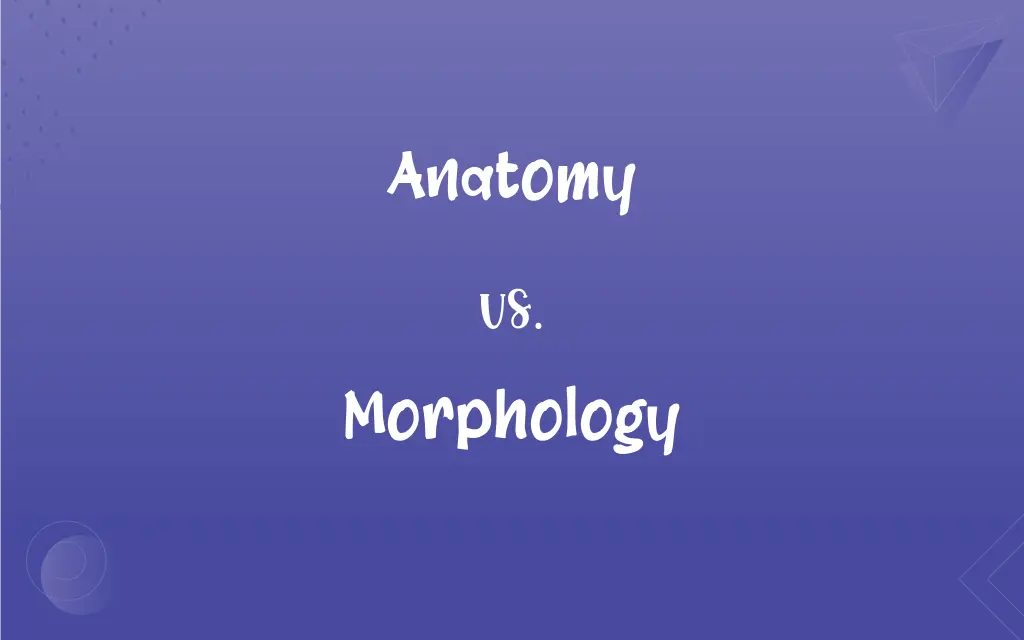Anatomy vs. Morphology: What's the Difference?
Edited by Harlon Moss || By Janet White || Published on January 4, 2024
Anatomy studies the structure and organization of living organisms; morphology examines the form and structure of organisms and their specific structural features.

Key Differences
Anatomy is the scientific study of the internal and external structures of living organisms. Morphology, while also concerned with structure, focuses more broadly on the form and design of organisms, encompassing both internal and external features.
Anatomy is crucial in fields like medicine and biology, providing detailed insights into the body's systems. Morphology extends to various biological disciplines, analyzing structural variations and adaptations in different species.
Anatomy often delves into the microscopic aspects of organisms, including cellular and tissue-level structures. Morphology typically deals with more macroscopic elements, like the shape, size, and external features of organisms.
Anatomy is commonly associated with the human body, but it also applies to other animals. Morphology spans across all living organisms, studying form and structure in animals, plants, and even microorganisms.
Anatomy primarily describes current structural compositions. Morphology often includes an evolutionary perspective, examining how structures have evolved and adapted over time.
ADVERTISEMENT
Comparison Chart
Focus
Internal and external body structures
Form and structure of organisms
Applications
Medicine, human and animal biology
Broad biological applications
Level of Detail
Cellular and tissue level
Often macroscopic, including shape and size
Primary Subjects
Human and animal bodies
All living organisms
Perspective
Structural composition
Evolutionary adaptations and variations
ADVERTISEMENT
Anatomy and Morphology Definitions
Anatomy
Examination of internal and external body parts.
Anatomy classes often include dissection to understand internal organs.
Morphology
Analysis of organismal shape, size, and structure.
Bird morphology studies variations in beak and feather shapes.
Anatomy
Analysis of the bodily systems and their functions.
Studying the anatomy of the heart helps understand its pumping mechanism.
Morphology
Focus on external features and overall design.
Morphology is used to categorize different insect species.
Anatomy
Focus on physical structure at both macroscopic and microscopic levels.
Anatomy explores structures ranging from whole limbs to individual cells.
Morphology
Study of the form and structure of organisms.
Plant morphology involves examining leaf shapes and flower structures.
Anatomy
A branch of biology and medicine concerning organism structure.
Comparative anatomy compares structures across different species.
Morphology
Includes evolutionary aspects of structure.
Morphological studies show how fish fins have evolved.
Anatomy
Study of the structure of organisms.
Medical students take courses in human anatomy.
Morphology
Broad application across all living organisms.
Fungal morphology examines the unique structures of mushrooms and molds.
Anatomy
The bodily structure of a plant or an animal or of any of its parts.
Morphology
The branch of biology that deals with the form and structure of organisms without consideration of function.
Anatomy
The science of the shape and structure of organisms and their parts.
Morphology
The form and structure of an organism or one of its parts
The morphology of a cell.
The morphology of vertebrates.
FAQs
Can anatomy include microscopic structures?
Yes, it covers both microscopic and macroscopic levels.
Does morphology only study external features?
It mainly focuses on external features but can include internal aspects.
What is anatomy?
Study of the structure and organization of living beings.
What is morphology?
Study of form and structure in organisms.
Can morphology help in species identification?
Yes, it's crucial for classifying and identifying species.
Is anatomy important in medical education?
Yes, it's fundamental for understanding the human body.
How does anatomy differ from morphology?
Anatomy is more focused on internal structures; morphology includes external features.
Are morphology studies relevant in evolution?
Yes, they provide insights into evolutionary adaptations.
Is morphology used in botany?
Yes, it's significant in studying plant structures.
How does morphology relate to taxonomy?
It helps classify organisms based on structural traits.
Are human anatomy and animal anatomy significantly different?
There are differences, but also many similarities.
How is morphology used in paleontology?
To analyze and interpret the forms of extinct species.
Does morphology include cellular structures?
It's more focused on larger, often visible structures.
Can anatomy explain organ functions?
Yes, it links structure with function.
What is the importance of comparative anatomy and morphology?
They offer insights into evolutionary relationships and functional adaptations.
Do anatomy studies apply to animals?
Yes, anatomy applies to both humans and animals.
Does anatomy involve dissection?
Often, especially in educational settings.
Does anatomy only deal with living organisms?
It primarily studies living organisms, but also applies to the study of fossils.
Is morphology important in ecology?
Yes, as it helps understand organism-environment interactions.
What tools are used in anatomical studies?
Microscopes, dissection tools, and imaging technology.
About Author
Written by
Janet WhiteJanet White has been an esteemed writer and blogger for Difference Wiki. Holding a Master's degree in Science and Medical Journalism from the prestigious Boston University, she has consistently demonstrated her expertise and passion for her field. When she's not immersed in her work, Janet relishes her time exercising, delving into a good book, and cherishing moments with friends and family.
Edited by
Harlon MossHarlon is a seasoned quality moderator and accomplished content writer for Difference Wiki. An alumnus of the prestigious University of California, he earned his degree in Computer Science. Leveraging his academic background, Harlon brings a meticulous and informed perspective to his work, ensuring content accuracy and excellence.

































































